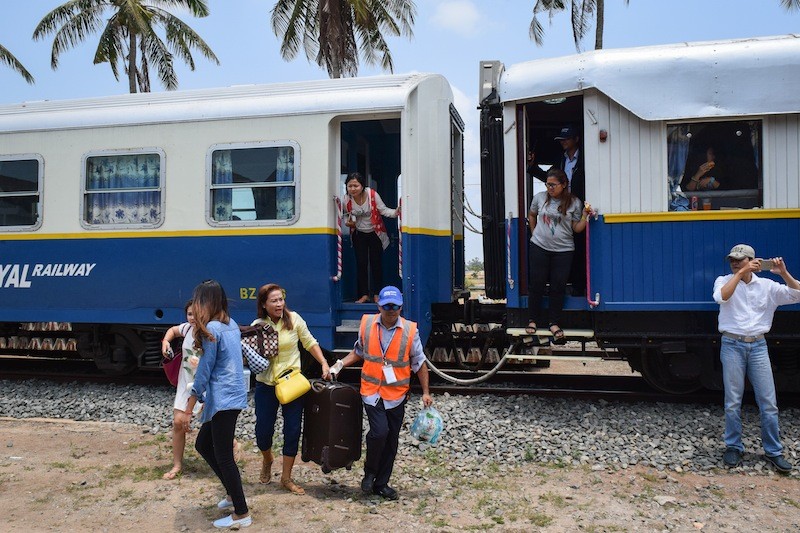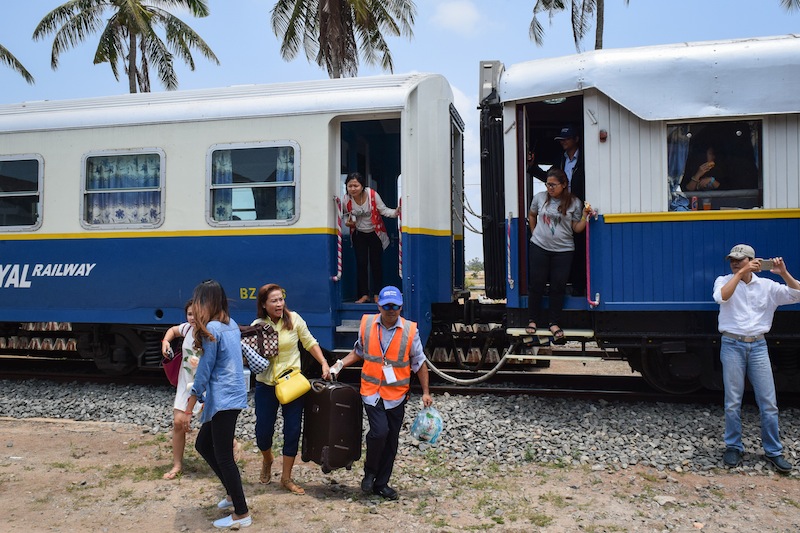For most people who boarded the passenger train from Phnom Penh to Sihanoukville on Saturday morning—the maiden ride since the service was suspended more than a decade ago—it was something of a new thrill.
But for Buo Than, the trip came with a touch of nostalgia.

“I am glad I am able to do this again,” the 68-year-old farmer from Kandal province said, sitting next to a window on the way to meet her son in Sihanoukville.
“Maybe when the Vietnamese were still here,” she said of the last time she made the trip by train, referring to the socialist 1980s. “It was a dangerous time to travel outside of Phnom Penh.”
Ending a 14-year hiatus, the passenger service between the country’s commercial hub and one of its most popular tourist destinations will run until April 17—coinciding with the Khmer New Year—in a test of the rail line’s capacity and demand from travelers, said John Guiry, the CEO of Royal Railway, which runs the service.
Speaking from the platform of Phnom Penh’s train station, Mr. Guiry said five carriages had been renovated for the service, including two air-conditioned cars, two cars fitted with fans and a wood-paneled “royal” carriage intended for private catering. The air-conditioned cars, which hold 170 people total, will travel to the coast on odd days, returning on even ones, with the other two cars, which have a capacity of 130, running on the opposite schedule—all trains departing at 7 a.m.
During Saturday’s inaugural trip, with about 200 passengers riding in five cars, few were watching the two Charlie Chaplin war movies—“The Great Dictator” and “Soldier Arms”—that played on loop throughout the journey. Most eyes were looking out the window, taking in the unique journey through the country’s southwest.
“I wanted to know how it feels to travel this way,” said 30-year-old Ouk Sivon, who was traveling in a fan carriage with the windows open along with a group of colleagues from the Caminco Insurance company.

“We go to the coast every year, but we normally take the bus,” she explained. “If they can make it a bit faster, then we will take this way again. It is great to smell the fresh air.”
Although the 266 km journey was scheduled to take eight hours—more than three hours slower than comparable road transport—it only took 20 minutes for the train to clear the western sprawl of Phnom Penh, turning south near the airport to begin its slow progress to the coast.
Sharing a similar route to National Road 3 in some stretches, parched rice paddies made up much of the view. However, the train passed some notable landmarks, including Bokor Mountain.
“Look at that, how cool!” Khim Chakry said to his wife as the train passed cave-studded limestone karsts in Kampot province.
“I have taken the bus on this road many times and never knew these were here,” said the 32-year-old employee at a telecoms firm, adding that the slow pace of the train allowed him to focus on the scenery.
As the train made its way south, an oft-used horn cleared cows from the tracks and announced its pending arrival at numerous road crossings, both manned and unmanned, and some without any apparent barrier to stop traffic.
The service made two stops before Sihanoukville, arriving at the Takeo train station at 9:07 and the Kampot station at 11:30. It pulled into the newly refurbished Sihanoukville station just after 2:30 p.m—a seven and a half hour journey—to a greeting of “Happy New Year!” from tourism officials and local business owners competing with tuk-tuk drivers to be the first to welcome passengers.
“In short, it has been a success, and we are just hoping now that everyone agrees with me and enjoyed the trip,” Mr. Guiry said on the platform in Sihanoukville.
“If it continues like today, and the support is the way it is, we will have to think about what we do next,” he said. “Do we just do the next holiday, or do we go for just weekends, and what sort of service do we offer?”




